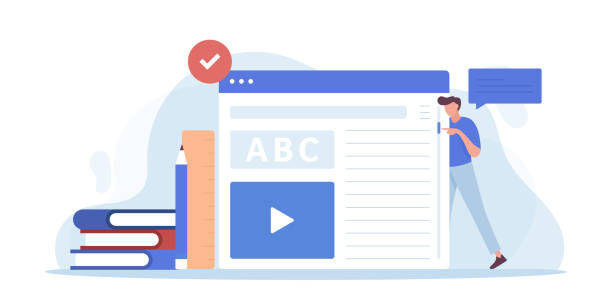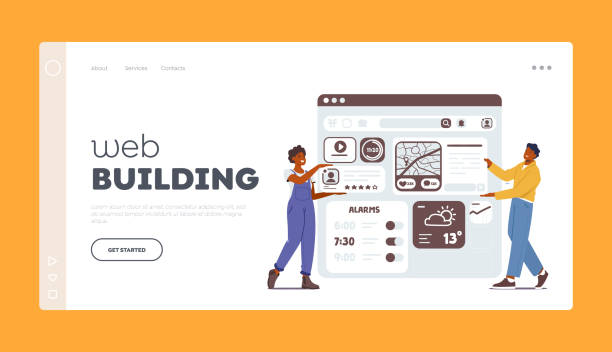The Unparalleled Importance of User-Friendly Website Design in Today’s World

In the current digital age, user-friendly website design is no longer a competitive advantage but an absolute necessity.
If you want your website to not only be seen but also to attract and retain users, you must pay special attention to #user_experience and #user_interface.
A poorly designed site can quickly drive visitors away, even if it contains very valuable content.
Imagine entering a physical store where it’s difficult to find products, the checkouts are crowded, and the staff are rude; it would undoubtedly be an unpleasant experience.
The same rule applies to websites.
A website that is difficult to navigate, where necessary information is not easily found, and whose visual design is irritating, will soon be abandoned by users.
This not only affects the Bounce Rate but also negatively impacts brand credibility and ultimately your sales or business goals. User-friendly website design means creating a clear and pleasant path for users to easily find what they are looking for.
This explanatory approach demonstrates why investing in excellent web design is crucial.
Today’s users come with high expectations; they quickly seek answers to their questions and prefer to browse in an environment that gives them a sense of calm and efficiency.
Therefore, every website, from a personal blog to a large online store, must place this principle at its core.
Ignoring this aspect means ignoring a significant portion of potential audiences.
The importance of user-friendly website design in your online success is undeniable.
This approach not only leads to increased user satisfaction but also directly affects SEO and your site’s ranking in search engines.
Are you dissatisfied with low sales from your e-commerce site?
Rasawob is your solution for a professional and high-selling e-commerce website.
✅ Significant increase in sales and revenue
✅ Easy and enjoyable shopping experience for customers
⚡ Get free consultation from Rasawob now!
Fundamental Principles of User Experience (UX) and User Interface (UI) Design

To achieve a user-friendly website design, it is necessary to be familiar with the basic principles of User Experience (UX) and User Interface (UI) design.
UX refers to all the feelings and experiences a user has when interacting with your website, while UI deals with the visual aspects and interactive elements of the site such as buttons, forms, and menus.
These two concepts are highly intertwined and inseparable.
Good design from a UX perspective means responding to user needs, providing a logical and easy path to access information or perform tasks, and creating an overall sense of satisfaction.
This specialized approach helps us to focus beyond mere aesthetics to the actual efficiency and performance of the site.
Key UX principles include Usability, Accessibility, Usefulness, and Desirability.
A usable website should be easy to learn, efficient, error-free, and memorable.
On the other hand, User Interface (UI) design should encompass visual harmony, simplicity, and clarity.
Proper use of whitespace, selection of readable fonts, attractive color schemes, and intelligent use of icons all contribute to improving UI.
In a user-friendly website design, UI is not just about aesthetics but also a tool to guide the user and improve their interaction with the site.
By optimally combining these two, we can ensure that users not only enjoy the site’s appearance but also easily achieve their goals and have a positive experience.
These principles are essential for anyone looking to create a successful website.
Easy Navigation and Logical Information Architecture

One of the main pillars of a user-friendly website design is an easy Navigation system and logical Information Architecture.
The user should be able to quickly access any part of the site they need without confusion.
This is an educational aspect that helps designers and developers create a suitable structure for their content.
Menus should be clear, concise, and predictable.
Using Sticky Navigation, which remains accessible while scrolling, can significantly improve the user experience.
Additionally, an organized Sitemap and the use of Breadcrumbs help users understand their position on the site and easily return to previous pages.
Information architecture refers to how content is organized and labeled on a website.
How categories, subcategories, and single pages are linked directly impacts the ease of finding information.
Poor information architecture can lead to user confusion, increased bounce rates, and reduced engagement.
To create a user-friendly website design, you must view content from the user’s perspective and anticipate the most likely paths users will take to find information.
User needs analysis and Usability Testing are crucial at this stage to ensure our information structure aligns with users’ mental models.
| Navigation Element | Impact on User-Friendliness | Example |
|---|---|---|
| Main Menu (Header Menu) | Quick access to key sections of the site | “Home, About Us, Services, Products, Contact Us” |
| Breadcrumbs | Shows user’s position and guide to return | “Home > Products > Category > Specific Product” |
| Search (Search Bar) | Finding specific content without the need for navigation | Magnifying glass icon in the top right corner |
| Footer Menu | Less critical links, contact and legal information | “Privacy, Terms & Conditions, Careers, Sitemap” |
| Filters and Sorting | Helps find desired information in long lists | Filter products by price, color, brand |
Attractive Visual Design and Brand Consistency

Visual Design is a crucial element in user-friendly website design.
Your website’s appearance is the first thing a user encounters and greatly influences their initial impression and sense of trust.
An attractive visual design not only attracts users but also helps strengthen your brand identity.
Using appropriate colors, readable fonts, high-quality images, and balanced Layouts all play a role in creating a pleasant visual experience.
This entertaining approach can keep visitors on your site longer and encourage them to explore further.
Visual consistency across the website is very important.
Using a consistent Design System, including color palette, typography, and icon style, gives your website a professional and unified feel.
This makes it easier for users to identify interactive elements and understand how to interact with the site.
Additionally, choosing images that are relevant to the content and of high quality adds to visual appeal and conveys your message more effectively.
Attention to Whitespace is also vital; this space allows content to “breathe” and improves readability, while preventing visual clutter and confusion.
A user-friendly website design is not just about good functionality, but also about beauty and visual pleasure.
Tired of losing customers due to poor e-commerce site design? With Rasawob, solve this problem forever!
✅ Increase sales and visitor-to-customer conversion rates
✅ Smooth and attractive user experience for your customers⚡ Get free consultation
Responsiveness and Accessibility for All

In today’s world, where using various devices to access the internet is common, Responsive Design is essential for any user-friendly website design.
A responsive website automatically adjusts its layout and content to the screen size of the user’s device, from desktops to tablets and mobiles, providing a seamless and optimized user experience.
This is a news aspect whose importance grows daily, as search engines like Google also prioritize responsive websites.
Ignoring this principle can lead to losing a significant portion of mobile audiences, who today account for a large share of internet traffic.
In addition to responsiveness, Accessibility is also a key principle in user-friendly website design.
This means designing a website that can also be used by people with disabilities.
This includes providing Alt Text for images for visually impaired users, enabling keyboard navigation for those who cannot use a mouse, and providing captions for video content.
Adhering to accessibility standards like WCAG (Web Content Accessibility Guidelines) is not only a social responsibility but can also expand your target market.
A website that is accessible to everyone demonstrates your commitment to ethical principles and providing a positive experience for every individual.
This guidance approach helps you optimize your website for a wider community.
The Importance of Content in Attracting and Retaining Users

Alongside visual and functional design, content is king and plays a fundamental role in user-friendly website design.
Even the best design cannot save poor content.
Your content must be relevant, valuable, engaging, and easily understandable.
This includes text, images, videos, and any other type of information you provide on your website.
From a thought-provoking content perspective, you should ask yourself: “Does my content answer users’ questions? Does it solve their problems?”
For a user-friendly website, content should be structured and organized.
Using clear headings (H1, H2, H3), short paragraphs, bulleted lists, and appropriate whitespace significantly increases readability.
Use simple and understandable language and avoid complex technical jargon that your general audience may not be familiar with.
The Call to Action (CTA) should be clear and prominent so that the user knows what to do after reading the content.
Your website content should not only provide information but also engage the user and encourage them to interact further with the site. Regularly updating content and providing fresh, engaging content also helps retain users and improve the site’s ranking in search engines.
This is an analytical approach that must be continuously evaluated.
Optimizing Website Loading Speed and Performance

Website loading speed is a critical factor in user-friendly website design and the overall user experience.
Research has shown that users expect a website to load in less than a few seconds, and every second of delay can lead to increased bounce rates and dissatisfaction.
Search engines also consider site speed as an important ranking factor. Therefore, performance optimization is a specialized aspect that requires technical knowledge and specific tools.
Several key actions can be taken to improve site speed.
These include compressing images without reducing quality, using Browser Caching, minimizing CSS and JavaScript files, and choosing high-quality Hosting.
Using a Content Delivery Network (CDN) can also significantly increase loading speed for users in different parts of the world.
Furthermore, optimizing website code and removing unnecessary code helps lighten pages.
Tools like Google PageSpeed Insights can help you identify speed issues and provide improvement solutions.
A user-friendly website design should never be compromised by slow loading speeds, as this can directly affect your online reputation and success.
| Optimization Factor | Description | Impact on Speed |
|---|---|---|
| Image Compression | Reduces image file size without significant loss of quality. | Significant increase |
| Browser Caching | Stores static site files in the user’s browser. | Increase in subsequent visits |
| Minification of CSS and JS | Removes extra characters (spaces, new lines) from code. | Minor to moderate improvement |
| Strong Hosting | Choosing high-speed and reliable servers. | Foundation of high speed |
| CDN (Content Delivery Network) | Delivers content from the closest server to the user. | Global speed improvement |
Usability Testing and User Feedback Collection

A user-friendly website design is an iterative process and does not end with the site launch.
Usability Testing and collecting feedback from real users are crucial steps to ensure the site’s correct and optimal performance.
This is an educational approach that helps you identify and fix your site’s weaknesses.
Usability testing can be done formally (with specific scenarios and planned participants) or informally (by observing users while they are using the site).
Tools like Google Analytics can provide valuable data about user behavior, such as popular pages, bounce rate, time spent on site, and navigation paths.
Heatmaps and Session Recordings also allow you to see exactly where users click, how much they scroll, and what problems they encounter.
Additionally, feedback forms, surveys, and live chat with users can provide important qualitative information.
By thoroughly analyzing this feedback, you can implement continuous improvements in your user-friendly website design and ensure that your site constantly meets user needs and expectations.
This continuous improvement process keeps your site alive and more dynamic.
Did you know that 94% of users’ first impressions of a business are related to its website design? With professional corporate website design by **Rasawob**, turn this first impression into an opportunity for growth.
✅ Attract more customers and increase sales
✅ Build credibility and trust in the audience’s eyes⚡ Get a free website design consultation!
Future Trends in User-Friendly Web Design

The world of web design is constantly evolving, and to maintain a user-friendly and competitive website design, it is necessary to be familiar with future trends.
This is a news aspect that helps us prepare for the future.
Artificial Intelligence (AI) and Machine Learning are playing an increasing role in personalizing the user experience, allowing websites to tailor content and offers based on past user behavior.
Also, Voice Search and Conversational UIs like chatbots are becoming more common ways for users to interact with websites.
Other important trends include Dark Mode design and subtle animations to enhance visual appeal and interaction.
The focus on sustainability and Green Design is also growing, meaning optimizing websites for lower energy consumption.
Microinteractions, which involve small and subtle feedback during user interaction with site elements, help improve user satisfaction and engagement.
By considering these trends, we can ensure that our user-friendly website design remains relevant and effective not only now but also in the future.
This analytical approach allows you to be a trailblazer.
Conclusion: Building a Website with an Excellent User Experience

Ultimately, user-friendly website design is the cornerstone of success for any online presence.
From the first visual impression to the ease of finding information and loading speed, every small detail can have a profound impact on the user experience.
This was a comprehensive guidance article to help you on this path.
We found that a successful design is not limited to mere aesthetics but involves a deep understanding of user needs, logical content structuring, performance optimization, and ensuring accessibility for all.
Investing in designing a user-friendly website means investing in the future of your business.
This not only leads to increased customer satisfaction, higher conversion rates, and reduced bounce rates but also strengthens your brand’s credibility and makes you more prominent in the eyes of search engines.
Remember that the process of creating a website with an excellent user experience is an ongoing journey that requires listening to feedback and making continuous improvements.
By focusing on and adhering to these principles, you can create a website that not only attracts visitors but also converts them into loyal customers and transforms your online presence into a powerful asset.
Frequently Asked Questions
And other services of Rasawob Advertising Agency in the field of advertising
Smart Digital Branding: A new service for enhanced campaign management through user experience customization.
Smart Advertorials: A combination of creativity and technology for digital branding through intelligent data analysis.
Smart Data Analysis: A fast and efficient solution for increasing sales, focusing on attractive user interface design.
Smart Sales Automation: A combination of creativity and technology for campaign management through custom programming.
Smart Marketing Automation: A professional solution for analyzing customer behavior with a focus on custom programming.
And over hundreds of other services in the field of internet advertising, advertising consultation, and organizational solutions
Internet Advertising | Advertising Strategy | Advertorials
Resources
Principles of User-Friendly Website Design
Importance of User Experience in Website Design
Effective Website Design for Business
Elements of Successful Website Design
? Are you ready for your business to soar in the digital world? Rasaweb Afarin Digital Marketing Agency assists you in achieving your goals by offering innovative and targeted solutions, including WordPress website design, SEO, and comprehensive marketing strategies.
📍 Tehran, Mirdamad Street, next to Bank Markazi, Southern Kazeroon Alley, Ramin Alley, No. 6



